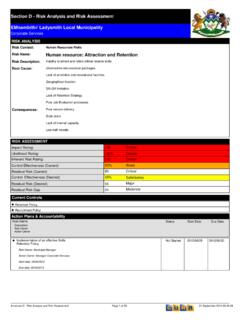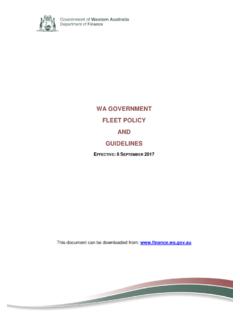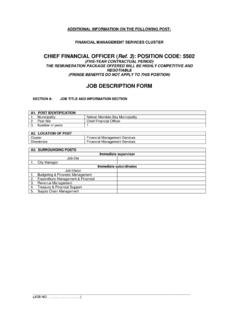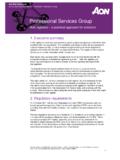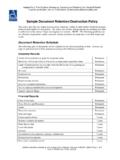Transcription of FLEET MANAGEMENT POLICY - Ladysmith
1 EMNAMBITHI / Ladysmith MUNICIPALITY FLEET MANAGEMENT POLICY 2 CO NT ENTS Page 01 Objectives 02 02 Background 03 03 Definitions 04 04 Responsibilities and Accountabilities Definitions 06 05 Internal Control 07 06 Procedure for Repairing of Vehicles, Plant and Equipment 1G0 07 Procedure for Issuance of Fuel, Diesel & Oil 11 08 Control Measures: Municipal Fuel Bowser 12 09 Filling of Municipal Vehicle with Fuel - Procedure for Weekends and Public Holidays 12 10 Authorised Signature 11 Mis us e of Official Vehicles 12 Permiss ion to take an Official Vehicle Home 13 Accidents 14 Subsidised Vehicles 15 Accounting for Vehicles.
2 Plant and Equipment 16 Authorised Signature for the Issue of Fuel to Municipal Vehicles Annexure "A" 17 Motor Vehicle Inspection Sheets Annexure "B" 18 Pool Vehicle Annexure "C" 19 Vehicle Log Sheet Annexure "D" 20 Service History Report Annexure "E" 21 Purchase Requisition Register Annexure "F" 22 Log Book Annexure "G" OBJ ECTIV ES 1. To ensure the effective and efficient control, utilization, safeguarding and MANAGEMENT of Municipality s vehicles plant and equipment. 2. To ensure that vehicle drivers and FLEET MANAGEMENT managers are aware of their responsibilities with regard to vehicles.
3 3 3. To set out the standards of physical MANAGEMENT , recording and internal controls to ensure that vehicles are safeguarded against inappropriate loss or utilisation. 4. To specify the process required before expenditure on vehicles is incurred. 5. To prescribe the accounting treatment for expenditure incurred on the use of vehicles, plant and equipment of the Municipality including: The criteria to be met before expenditure can be accounted for on vehicles, plant and equipment The criteria for determining the initial cost of the different vehicles, plant and equipment.
4 The method of calculating depreciation for different vehicles, plant and equipment The POLICY for scrapping and disposal of vehicles, plant and equipment. The classification of vehicles, plant and equipment BACKGROUND The utilization and MANAGEMENT of vehicles, plant and equipment is the prime mechanism by which a municipality can fulfil its constitutional mandates for: Delivery of sustained services, So ci a l an d e con om i c de ve l o pm en t, Promoting safe and healthy environments and, 4 Providing the basic needs to the community As trustees on behalf of the local community, the municipality has a legislative and moral obligation to ensure it implements policies to safeguard the monetary value and future services provision invested on vehicles.
5 The FLEET MANAGEMENT POLICY deals with the municipal rules required to ensure the enforcement of appropriate stewardship of vehicles. Stewardship has two components being the: Financial administration by the financial officer, and Physical administration by the FLEET MANAGEMENT managers Statutory provisions are being implemented to protect public property against arbitrary and inappropriate MANAGEMENT or disposal by a local government. Accounting standards will be set to ensure the appropriate financial treatment for different types of vehicles. The requirements of these new accounting standards include: The compilation of vehicle registers covering all vehicles controlled by the municipality.
6 Accounting treatment for the acquisition, disposal, recording and depreciation of vehicles, plant and equipment. The standards to which these financial records must be maintained. DEFINITIONS Accounting Standard Board Was established by the Public Finance MANAGEMENT Act to set standards of Generally Recognised Accounting Practice [GRAP] as required by the Constitution of the Republic of South Africa. Vehicles, Plant and Equipment 5 Are resources controlled by an entity as the result of past events and from which future economic benefits or future service potential are expected to flow to the entity.
7 FLEET Managing Manager Is the senior manager who has the functional accountability for and control of the physical MANAGEMENT of particular vehicles in order to achieve the municipality s strategic objectives relevant to their department. The execution of this responsibility will require the asset manager to control the acquisition, utilisation, MANAGEMENT and disposal of this set of vehicles to optimise the achievement of these objectives. Capitalisatio n Is the recognition of expenditure as an asset in the Financial Asset Register Carrying amount Is the amount at which vehicles are included in the balance sheet after deducting any accumulated depreciation thereon Cost of acquisition Are all the costs incurred in bringing an item or vehicle to the required condition and location for its intended us e Depreciable amount Is the cost of a vehicle, or other amount of a vehicle, or other amount substituted for cost in the financial statements less its residual value.
8 Fair value Is the amount for which a vehicle could be exchanged between knowledgeable willing parties in an arm s length transaction Financial vehicle register Is the controlled register recording the financial and other key details for all municipal vehicles recognized in accordance with this POLICY . GAM AP Stands for general accepted municipal practice GRAP Stands for accepted accounting practice Recoverable amount 6 Is the amount that the municipality expects to recover from the future use of a vehicle, including its residual value on disposal. Recognit ion Is the net amount that the municipality expects to obtain for a vehicle at the end of its useful life after deducting the expected costs of disposal.
9 Senior MANAGEMENT Are the incumbents of post level 1 and 2 in each directorate being the senior manager Stewardship Is the act of taking care and managing vehicle on behalf of another Useful life is either [a] The estimated period of time over which the future economic benefits or future service potential embodied in an asset are expected to be consumed by the municipality [b] The estimated total services potential expressed in term of production or similar units that is expected to be obtained from the asset by the municipality Responsibilit ies and accountabilities DRIV ERS The drivers of the Municipalities vehicles, plant and equipment are personally liable for the moving violation of vehicles such as: Speeding Reckless driving 7 Safety belt Overloading Parking offences Camera offences etc.
10 Committed with a Municipal vehicle A basic inspection must be carried out by the driver of the vehicle, plant or equipment and regularly by the departmental mechanic before leaving the premises of the Municipality Before proceeding on any journey, drivers are required to ensure that the vehicles conforms to the requirements of the Road Traffic Act in respect of brakes, lights, rear view mirror, condition of tyres, etc. If the vehicle does not conform to any of these requirements, the driver should report defects to the supervisor who in turn will get the vehicle repaired. In the event of any defect the vehicle may not be used until repaired Each and every vehicle must have a logbook, whereby all trips undertaken will be recorded and fuel consumption will be calculated against the distance travelled on a daily basis.




